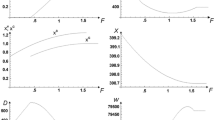Abstract
In this paper, we introduce the notion of "best practice" or "minimal extrapolation" regulation, and we show that cost reimbursement based on best practice norms may be (second best) optimal when the regulated firms have superior technological information and make non-verifiable cost reductions. In particular, we investigate the use of Data Envelopment Analysis (DEA) in regulatory environments with considerable technological uncertainty. A series of DEA models, including the crs, drs, vrs, fdh and frh models, are considered, and it is shown that schemes which reimburse actual costs plus a fraction of DEA estimated cost reductions will (1) induce the firms to minimize costs and (2) minimize the informational rents of the firms.
Similar content being viewed by others
References
P. Andersen and N.C. Petersen, A procedure for ranking efficient units in Data Envelopment Analysis, Management Science 39(1993)1261–1264.
R.D. Banker, A game theoretic approach to measuring efficiency, European Journal of Operational Research 5(1980)262–268.
R.D. Banker, Estimating most productive scale size using Data Envelopment Analysis, European Journal of Operational Research 17(1984)35–454.
R.D. Banker, A. Charnes and W.W. Cooper, Some models for estimating technical and scale inefficiencies in Data Envelopment Analysis, Management Science 30(1984)1078–1092.
R.D. Banker, A. Charnes, W.W. Cooper and R. Clarke, Constrained game formulations and interpretations for Data Envelopment Analysis, European Journal of Operational Research 40(1989) 299–308.
P. Bogetoft, DEA on relaxed convexity assumptions, Management Science 42(1996)457–465.
P. Bogetoft, Incentives and productivity measurements, The International Journal of Production Economics 39(1995)67–81.
P. Bogetoft, Incentive efficient production frontiers: An agency perspective on DEA, Management Science 40(1994)959–968.
P. Bogetoft, Non-Cooperative Planning Theory, Lecture Notes in Economics and Mathematical Systems 418, Springer, 1994.
A. Charnes, W.W. Cooper and E. Rhodes, Measuring the efficiency of decision making units, European Journal of Operational Research 2(1978)429–444.
A. Charnes, W.W. Cooper and E. Rhodes, Short communication: Measuring the efficiency of decision making units, European Journal of Operational Research 3(1979)339.
M.A. Crew and M.R. Frierman, Information economics and new forms of regulation, in: Competition and Regulation of Utilities, M.A. Crew, ed., Kluwer Academic, 1991, pp. 157–172.
D.M. Dalen, Strategic Responses to relative evaluations of bureaus: Implications for bureaucratic slack, Working Paper, Department of Economics, University of Oslo, 1993.
G. Debreu, The coefficient of resource utilization, Econometrica 19(1951)273–292.
D. Deprins, D. Simar and H. Tulkens, Measuring labor efficiency in post offices, in: The Performance of Public Enterprises: Concepts and Measurements, M. Marchand, P. Pestieau and H. Tulkens, eds., North-Holland, 1984, pp. 243–267.
M.A. Einhorn, Price Caps and Incentive Regulation in Telecommunications, Kluwer Academic, 1991.
B. Holmstrom, Moral hazard in teams, Bell Journal of Economics 13(1982)324–340.
J.J. Laffont, The new economics of regulation ten years after, Econometrica 62(1994)507–537.
J.J. Laffont and J. Tirole, Using cost observation to regulate firms, Journal of Political Economy 94(1986)614–641.
J.J. Laffont and J. Tirole, A Theory of Incentives in Procurement and Regulation, MIT Press, 1993.
C.T. Ma, J. Moore and S. Turnbull, Stopping agents from cheating, Journal of Economic Theory 46(1988)355–372.
B.M. Mitchell and I. Vogelsang, Telecommunication Pricing: Theory and Practice, Cambridge University Press, 1991.
N.C. Petersen, Data Envelopment Analysis on a relaxed set of assumptions, Management Science 36(1990)305–314.
A. Shleifer, A theory of yardstick competition, Rand Journal of Economics 16(1985)319–327.
K.A. Strasser and M.F. Kohler, Regulating Utilities with Management Incentives, Quorum Books, Greenwood Press, CT, 1989.
H. Tulkens, On FDH efficiency analysis: Some methodological issues and applications to retail banking, courts and urban transit, Journal of Productivity Analysis 4(1993)183–210.
P. Wunsch, Peer comparison, regulation and replicability, Working Paper, CORE, Université Catholique de Louvain, 1994.
Rights and permissions
About this article
Cite this article
Bogetoft, P. DEA-based yardstick competition: The optimality of best practice regulation. Annals of Operations Research 73, 277–298 (1997). https://doi.org/10.1023/A:1018985313272
Issue Date:
DOI: https://doi.org/10.1023/A:1018985313272




